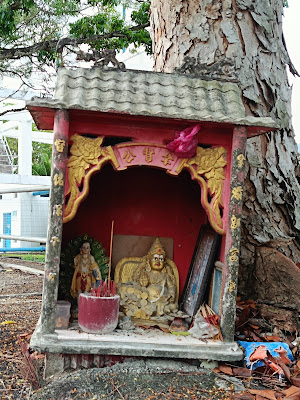Before I go any further, I should mention that this peculiar local guardian spirit is sometimes called Natok Kong, or even Latok Kong. Why? Because in the old days, Chinese settlers had trouble pronouncing certain Malay words, and Natok Kong or Latok Kong just stuck.
These shrines aren’t grand temples like the ones dedicated to well-known Chinese deities. They’re usually small, tucked into corners, by the roadside, nestled beneath trees or standing quietly outside homes and businesses, some private and some public—especially in areas with large Chinese communities. But even with their modest appearances, they hold immense significance for those who worship there.
The Datuk Kong isn’t just one deity; it’s a general term for guardian spirits believed to watch over specific places. Some say each Datuk Kong was once a real person—an early settler, a respected village elder or a local leader who shaped the land’s history. Others believe these spirits are tied to nature, acting as protectors of the land, trees and hills. Whatever the origins, one thing’s clear: their presence is deeply woven into the lives of the people who revere them.
What makes the worship of Datuk Kong fascinating is how it blends Chinese folk traditions with Malay spiritual beliefs. The name itself—Datuk, a Malay honorific—already hints at this fusion. As Chinese immigrants settled in the Nanyang, they encountered local traditions and incorporated certain elements into their own practices. And so, the Datuk Kong became a figure straddling different worlds and cultures, and embodying Taoism and indigenous animistic beliefs all at once.
No two Datuk Kong shrines are exactly alike. Some are just humble altars with a single Datuk Kong statue or figurine and incense burners, while others are more elaborate, featuring multiple and different Datuk Kong statues together, red lanterns, banners and plaques inscribed with prayers or auspicious words. Occasionally, there's no statue at all. Instead, I've seen earth mounds, termite mounds, boulders draped in yellow cloth. even red wooden plaques with gold-painted Chinese characters, to represent the deity—emblems of the Datuk Kong’s presence in nature. Offerings vary too—flowers, fruits, tea and even traditional Malay delicacies like sireh and pulut (glutinous rice) are common. But one rule is almost always observed: no pork. Since many Datuk Kong spirits are believed to have Islamic roots, worshippers take great care to keep offerings halal. If anything, this small but significant detail reflects the harmonious blending of cultures that defines Malaysia’s spiritual landscape.Sometimes, though, the Datuk Kong doesn’t even have a physical shrine, but they are there all the same. When we step into parks, forests or mountains, we just know the spirits are there. It’s an unspoken understanding—we respect their presence, and in return, we hope they don’t disturb us. Some people even carry joss sticks, ready to offer a quiet prayer to appease them and ask for forgiveness for any unintentional transgressions, just in case. And I say this from personal observation—I’ve seen friends bring joss sticks to Kedah Peak when we visited in the 1970s, long before it was developed into the Jerai Hill Resort like it is today.
For those who pray at these shrines, Datuk Kong isn’t just a guardian of the land—he’s a protector, a giver of wisdom, someone to turn to in times of need. A shopkeeper might light incense and ask for prosperity in business. A traveller might pause to seek safe passage. A family might offer prayers for good health and peace at home. Whether these requests are granted is, of course, a matter of faith. But ask any believer, and they’ll tell you—Datuk Kong watches over them, in quiet but steadfast presence.
And despite the ever-changing world around them—where old villages give way to skyscrapers and traditions constantly evolve—these small shrines remain. They’re a silent but enduring reminder of the past, a testament to a community that continues to find comfort in its spiritual roots. It’s an unspoken understanding, one that bridges cultures, connects generations and, in its own quiet way, keeps the spirit of Datuk Kong alive.
Note: I wrote about unintentional transgressions above. But what about the intentional ones—the kind that affect innocent parties? Just last month, I heard a story about someone—an artist, apparently—who thought it’d be cool to paste a picture of a well-known local art celebrity over the face of a Datuk Kong statue. He brushed it off as nothing more than artistic expression, just a bit of creative flair. No harm intended.
But whether he meant any harm or not, something strange happened soon after. The person whose face was used in this so-called "art piece" started experiencing some unexplained health issues. Nothing life-threatening, but troubling enough that it couldn’t be ignored. It got to the point where his family felt compelled to seek forgiveness. And once they did, the health problems reportedly eased.
Sceptics might scoff and call it pure coincidence. And maybe it was. But if there’s one takeaway from stories like this, it’s that local spiritual cultures—whether you personally believe in them or not—are not to be taken lightly. Some things, some traditions, have a way of demanding attention and respect. Best not to tempt fate.
Note: These pictures of roadside Datuk Kong shrines were taken during my walks around the neighbourhood. Maybe I should revisit these shrines to get updated pictures of these statues.






No comments:
Post a Comment